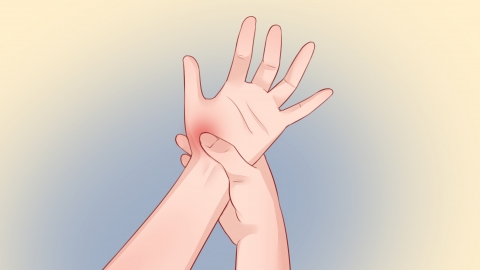What causes pain in the wrist and palm?
Generally, pain in the wrist and palm may be caused by overuse, poor hand posture, tenosynovitis, carpal tunnel syndrome, rheumatoid arthritis, and other factors. It is recommended to seek medical attention promptly, identify the underlying cause, and receive symptomatic treatment under a doctor's guidance. Specific analyses are as follows:

1. Overuse injury: Long-term, frequent activities such as typing, doing housework, or lifting heavy objects can place continuous strain on the muscles and tendons of the wrist and palm, easily leading to pain. It is advisable to reduce manual labor, take a 10-minute break after every hour of hand use, and use warm water soaks or gentle massage of the wrist and palm muscles to promote blood circulation and relieve pain.
2. Poor hand posture: Keeping the wrist bent for prolonged periods while using a mobile phone or letting the wrist hover unsupported while using a mouse can lead to uneven stress on wrist and palm tissues, causing pain. Adjust hand posture accordingly—use a wrist pad when operating a mouse and keep the wrist naturally straight when using a phone. Avoid maintaining the same posture for extended periods to reduce tissue compression.
3. Tenosynovitis: Repeated friction of tendons in the wrist and palm can cause an aseptic inflammation, resulting in pain accompanied by local swelling and snapping sensations during movement. Patients may follow medical advice to use medications such as diclofenac sodium gel, ibuprofen sustained-release capsules, or celecoxib capsules to alleviate inflammation.
4. Carpal tunnel syndrome: Compression of the median nerve within the carpal tunnel leads to pain in the wrist and palm, often accompanied by numbness and weakness in the fingers. Patients may follow medical recommendations to use mecobalamin tablets, vitamin B1 tablets, or prednisolone acetate tablets to nourish nerves and reduce inflammation.
5. Rheumatoid arthritis: Autoimmune abnormalities trigger joint inflammation that affects the joints of the wrist and palm, causing pain along with joint swelling and stiffness, particularly noticeable upon waking. Patients should follow medical advice to use medications such as methotrexate tablets, leflunomide tablets, or sulfasalazine enteric-coated tablets to control disease progression.
Routine practice of gentle hand stretching exercises—such as slowly opening the fingers after making a fist or performing wrist circles—can strengthen the muscles of the wrist and palm. Wearing loose, comfortable gloves is also recommended to avoid excessive pressure from tight gloves and reduce triggers of pain.




